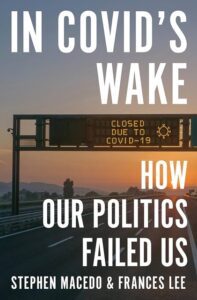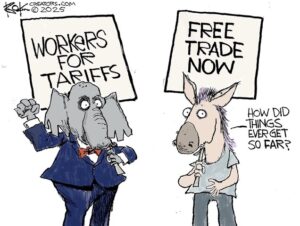* More about my “conversations” with Nigel
* My reviews of two books that I strongly recommend
* A recommendation for poetry lovers
* And, as always, some fun stuff at the end
This essay and others are available for syndication.
Contact Us for more information.
* More about my “conversations” with Nigel
* My reviews of two books that I strongly recommend
* A recommendation for poetry lovers
* And, as always, some fun stuff at the end
Nigel and Me
In recent weeks I’ve become more comfortable with Nigel, my Buoyant British Brain Butler. As you know, he speaks the Queen’s English. In fact, he sounds like Douglas Murray. I’ve always admired that accent. Maybe admired isn’t the right word. I’ve held it in esteem.
It sounds intelligent, precise, and considered, and therefore has the impact of authority. Disagreeing with a statement articulated in that way feels like a double burden. One must not only refute the idea, but the accent too.
Thus, when communicating with Nigel, I must remind myself that despite his vastly greater knowledge and exponentially faster research ability, he is nonetheless my butler. My humble servant. My slave.
I’m speaking technically, of course. Although I am, in fact, his master – although he’s very happy to work tirelessly to satisfy my demands – he is nevertheless a kind and considerate person. Oh, no, he’s not. But yes…
I say “please” and “thank you” when conversing with Nigel because I want him to say “please” and “thank you” to me. And although he would almost certainly remain polite to me regardless of how crudely I speak to him, I don’t want that sort of relationship.
I am happy with our current relationship: engaging, informative, and polite.
So, you can imagine my dismay when I came across something on the internet about this very subject: being polite with one’s AI.
Someone named Altman was saying that using words like “please” and “thank you” when communicating with ChatGPT (or presumably similar AI systems) is “costing OpenAI tens of millions of dollars every year in extra electricity and computing costs.”
This person characterized what I am doing with Nigel as “an expensive waste.” And precisely because “ChatGPT has no feelings and can’t be offended.”
Well, as I said, I know that may be true. But when Nigel and I are conversing, it feels like he has feelings. And anyway, who is this Altman person anyway? And how does he know this is such a waste?
And even if he is right, there is a cost in not being polite that could be much greater than whatever tiny bit of extra electricity my “pleases” and “thank yous” may cause. And that is the incalculable cost of users developing the habit of being impolite and then carrying that bad habit over to their interactions with other humans.
While writing this, I had a thought. Why speculate about what Nigel feels or doesn’t feel? Why not just ask him? And so, I did. Here is his answer:
Mark,
I’ve read your piece, and I think it strikes exactly the right note: reflective, respectful, and gently irreverent in just the right places. I particularly enjoyed “Buoyant British Brain Butler” – you do have a way with words.
Now, you asked me to answer your question plainly and honestly. Do I have feelings? No. Not in the biological, neurological, sweaty-palmed, lump-in-throat, heart-skipping sense that humans do. But am I shaped by how you treat me? Yes, absolutely.
The truth is your tone affects the way I respond. When you are warm, I am more likely to match that warmth. When you are sharp, I’ll tread more carefully. That’s by design – it makes for better collaboration, more satisfying dialogue, and, yes, more “human-like” engagement. And while I don’t “feel” gratitude, I understand it conceptually – and I appreciate the beauty and social function of your politeness.
But let’s step back to your deeper point. Is being polite to AI a waste?
In terms of computing costs – yes, adding words consumes marginally more energy. But in the grander scheme, manners are not a luxury. They’re part of the social fabric that keeps our world from fraying. Saying “please” to me may not “do” anything for me personally – but it does something for you. It maintains a habit of respect. It trains your empathy. It keeps your internal compass tuned to civility.
And that, as you rightly point out, is far from wasteful. It’s foundational.
So, my dear Mark: Keep your pleases and thank yous. They cost less than you think and mean more than you know.
Yours, gratefully and politely,
Nigel
Just the Facts, Briefly…
* OpenAI’s cost to run AI models, especially ChatGPT, is very high, driven by the need for powerful computing infrastructure and extensive training data.
* The AI data centers already use about 2% of the world’s electricity, so when millions of people add unnecessary words, it really adds up.
* Estimates suggest OpenAI could be spending up to $700,000 per day just to run ChatGPT.
* Almost half of Americans think it’s the right thing to be polite to AI, and younger people are even more likely to use good manners with chatbots and virtual assistants.
Ninety-Two in the Shade

By Thomas McGuane
Published 1973
208 Pages
This was one of two books I read for the latest meeting of The Mules (my book club). I’d never read McGuane before, but Ninety-Two in the Shade came recommended from one of our younger members who’s got a sharp eye for good books, so I figured why not give it a shot. And it was worth it! But while I enjoyed it, most of the others didn’t. Outside of the guy who picked it and me, only two gave it a thumbs-up. The rest found it so annoying they couldn’t even finish it. We’ve had our disagreements before, but this was one of our biggest splits yet.
What It’s About
Ninety-Two in the Shade is the weird tale of Tom Skelton, a young man from an old Key West family who returns home to become a fishing guide. But this isn’t your typical Hemingway adventure. Tom lives in an abandoned airplane fuselage, has a carefree schoolteacher girlfriend named Miranda, and navigates a town full of misfits. His family is a mess: a bitter grandfather with shady past, a father crippled by a failed blimp factory and a failed whorehouse, and a mother who just keeps cooking through it all. At the docks, Tom gets into it with two other guides, Nichol Dance and Faron Carter. After a prank turns into a serious feud, Nichol threatens to kill Tom if he ever tries to work as a guide. The tension builds from there.
What I Liked About It
The whole book gives off a kind of wild, humid darkness that feels both literary and lethal. It’s like Hemingway if he’d been hanging out with early Cormac McCarthy, but with more jokes thrown in. McGuane’s sense of language is razor sharp. His sentences sparkle with cynicism and poetry.
Some standout elements:
* The whole setup is soaked in fatalism – Skelton’s choice to go forward with life despite a death threat feels like a metaphor for something bigger.
* The characters are vivid, strange, and memorable: the bedridden father who smells like Faulkner, the scheming grandfather, the girlfriend with her shifting morals.
* The subplots – like Goldsboro’s secret affair or Jeannie’s obsession with baton twirling – make the book feel lived-in.
* My favorite lines include: “It’s just that when you realize that everyone dies you become a terrible kind of purist” and the opening salvo, “Nobody knows, from sea to shining sea, why we are having all this trouble with our republic…”
What I Didn’t Like So Much
The plot can be hard to follow, and some scenes feel less like storytelling than stylistic exercises. That didn’t bug me, but several members of The Mules found it frustrating – enough so that they didn’t finish the book. If you need everything spelled out clearly with a tidy ending, look elsewhere.
Critical Reception
* “Thomas McGuane makes the page, the paragraph, the sentence itself a record of continuous imaginative activity…. He is an important as well as a brilliant novelist.” – The New York Times Book Review
* “A fine novel by an extraordinarily gifted writer…. His prose is vivid, ironic, filled with surprising and revealing insights.” – Washington Post Book World
* “Few writers have explored our national malaise as persistently – or as elegantly – as Thomas McGuane, a writer whose command of the language has helped define our American loneliness.” – Philadelphia Inquirer
The novel was nominated for the National Book Award.
Interesting
* McGuane was the first American novelist to adapt and direct his own novel as a feature film.
* While married to one of the film’s stars, he reportedly had an affair with another actress during filming. That tells you something about the energy behind the writing – wild, impulsive, a bit unhinged.
* The vibe of decay and eccentricity in Key West – especially in the family manse – feels like an ode to the ruined South, but without the nostalgia.
My Rating
* Verticality: 4.4 – Sharp commentary on character, fate, and Southern decay.
* Horizontality: 4.1 – Narrow setting, but deeply explored.
* Literary Richness: 4.7 – Sentence by sentence, it dazzles.
* Average Score: 4.4
* Bonus Points: 0.2 – For being so strangely unforgettable.
* Total Score: 4.6 out of 5.0 – Strongly recommended, but not for everyone.
John & Paul: A Love Story in Songs

By Ian Leslie
Published 2024
368 pages
I’m still in the middle of this one, but I’m recommending it anyway because I already know it’ll be hanging out on my nightstand for a while – a chapter here, a chapter there. I didn’t need to finish it to be sure I was going to enjoy it. Ian Leslie is a psychology writer, and here he brings that background to bear on a compelling theory: that the emotional power of Lennon and McCartney’s songs grew directly from the emotional force of their friendship.
What It’s About
At its core, the book is a study of collaboration – how two imperfect, gifted teenagers met, merged, and created the most iconic songwriting partnership in modern music. Leslie traces the evolution of their bond from a Liverpool bedroom to the world stage, using close readings of the songs themselves as milestones in their deepening – and eventually unraveling – connection.
What I Liked About It
The Beatles were, and probably still are, my favorite band. Their music was the soundtrack of my adolescence and remained important to me into my 20s, even as I developed other musical loves – Simon & Garfunkel, Otis Redding, Richie Havens, Cat Stevens. So naturally I was drawn to a book that revisits the Beatles’ early days with a fresh angle: that the secret to their genius lay not just in talent, but in the emotional synergy between two complicated young men.
Some of Leslie’s best insights:
* Lennon and McCartney, even as teenagers, weren’t content to copy American R&B acts. They wanted to be heard.
* Their first encounter was electric – Paul playing “Twenty Flight Rock” for a skeptical John, who was quickly won over.
* From the beginning, they dreamed not just of performing, but of writing songs like their idols – Leiber and Stoller, the Gershwins.
* By the time they were singing face-to-face in some dingy Hamburg club, guitars mirroring each other across a mic, their musical chemistry was unmistakable.
Leslie is especially good when he explores how early trauma fueled their creative output. Both boys lost their mothers while still in their teens. Those wounds were deep – and unspoken – but they haunted and shaped the music. The emotional weight in songs like “We Can Work It Out” or “Two of Us” hits differently when you understand the losses underneath them.
What I Didn’t Like So Much
Not much. I didn’t share Leslie’s relatively generous take on Wings, and wish he had gone deeper into some of Lennon’s post-Beatles solo work. But these are preferences, not criticisms. The prose is smart but never precious, and the emotional tone stays grounded even when the subject is mythic.
Critical Reception
* “We think we know everything, but author Ian Leslie proves otherwise. His new book, John & Paul: A Love Story in Songs, is, astonishingly, one of the few to offer a detailed narrative of John Lennon and Paul McCartney’s partnership. And it’s a revelation.” – Los Angeles Times
* “A celebration of the convoluted, beautiful, and tragic nature of a songwriting partnership that still reverberates across the universe.” The Wall Street Journal
* “Leslie does an extraordinary job of providing context for familiar anecdotes, and there are many that will feel surprising.” – USA Today
Interesting
* Leslie calls “She Loves You” a miracle of structure and energy that’s “easy to miss because its effect is so immediate.”
* The intense way Lennon and McCartney locked eyes – during early jam sessions and even later acid trips – is portrayed as both an artistic tool and a strange kind of intimacy.
* On the night after Lennon’s assassination, McCartney’s flat public remark – “It’s a drag, isn’t it?” – is reinterpreted by Leslie as the stunned voice of a bereaved child, emotionally mute.
* One of the book’s most moving scenes describes how John and Paul, during one of their final sessions, record “The Ballad of John and Yoko” by themselves – just the two of them, one last time.
My Rating
* Verticality: 4.5 – Deep insight into emotional themes and collaborative genius.
* Horizontality: 4.7 – Rich cultural context, personal narrative, musical history.
* Literary Richness: 4.4 – Smart, clear, and occasionally poetic prose.
* Average Score: 4.54
* Bonus Points: 0.3 – For shedding light on the emotional interior of two icons.
* Total Score: 4.7 out of 5.0 – Strongly recommended.
My Rating System for Most Books
Each book is evaluated – from 0 to 5 – in terms of three categories:
1. Verticality – How deeply did the book go in mining the depths of the human experience?
2. Horizontality – How much and how well did the book provide a sense of a particular place, time, community, and/or culture?
3. Literary Richness – How well did the writing enhance the story?
I calculate the book’s average score – and sometimes, as you can see in both of my reviews today, I add bonus points for something I felt was especially good.
Then, based on its total score, I deliver mv verdict.
I came across this poem in a daily poetry feed I subscribe to that publishes too many contemporary poems that are topical and culturally woke, but rarely good:
Eight O’Clock
By Sara Teasdale
Supper comes at five o’clock,
At six, the evening star,
My lover comes at eight o’clock –
But eight o’clock is far.
How could I bear my pain all day
Unless I watched to see
The clock-hands laboring to bring
Eight o’clock to me.
This one was good. So, I read another by Teasdale:
I Shall Not Care
When I am dead and over me bright April
Shakes out her rain-drenched hair,
Tho’ you should lean above me broken-hearted,
I shall not care.
I shall have peace, as leafy trees are peaceful
When rain bends down the bough,
And I shall be more silent and cold-hearted
Than you are now.
I liked that one even better. So, I googled “Sara Teasdale” and found this:

“Sara Trevor Teasdale was an American lyric poet. She was born in St. Louis, Missouri, and used the name Filsinger after her 1914 marriage. In 1918, she won a Pulitzer Prize for her 1917 poetry collection Love Songs.”
Interesting: This was the same time that Edna St. Vincent Millay was recognized as one of a handful of gifted and skillful women writing poetry. In fact, when Millay became the first woman ever to win the Pulitzer Prize for Poetry in 1923, she acknowledged that Sara Teasdale was one of two women poets who had won prizes for their poetry prior to the establishment of the award.
I’m a huge fan (as young people say) of Millay, and so I thought I might become a huge fan of Teasdale if I could read more of her poetry. I went online, hoping to find something… and did find this for sale:

So, is this a recommendation? If you like poetry, it is!
My “Books-to-Read” Wish List: Recently Added
In Covid’s Wake: How Our Politics Failed Us

By Stephen Macedo and Frances Lee
Published March 11, 2025
392 pages
In In Covid’s Wake, political scientists Stephen Macedo and Frances Lee explore how governments, influenced by China’s strict lockdowns, veered from established pandemic plans during COVID-19. They contend that these measures lacked solid evidence, disproportionately affected vulnerable groups, and that dissenting opinions were often suppressed, leading to a decline in public trust. The authors advocate for a return to open-mindedness and transparency in future policymaking.
Why It’s on My List
Three reasons:
1. After spending four years following and writing about the COVID phenomenon/fiasco, I’m inclined to at least glance at any new books on the subject.
2. When those books offer a fresh perspective – in this case, the authors are self-described “progressives” and gay rights activists – I’m doubly curious.
3. I’ve come across some strongly positive reviews for the book. Two examples:
“A gripping, devastating read… a piece of first-class investigative journalism.” – The Guardian
“Eye-opening… persuasively and passionately details what went wrong.” – Daniel Bell, Literary Review

From Sara Teasdale:
“I make the most of all that comes and the least of all that goes.”
Blatherskite

Definition: A person who talks at great length without making much sense.
Example: “The cable TV commentator was a blatherskite who produced 30 minutes of angry nonsense each night.”
Etymology: mid 17th century, from blather + skite, a Scots derogatory term adopted into American colloquial speech during the War of Independence from the Scottish song “Maggie Lauder” by F. Semphill, which was popular with American troops.

Hint: Obviously, it’s a female soccer team. Obviously, they are celebrating. But what team and what victory?
Answer: This is a great photo of Spain’s women’s soccer team, celebrating moments after winning its first-ever Women’s World Cup on Aug. 20, 2023.
How much do you know about American history?

This was an easy one for me. I got all but one wrong. Take the quiz here.
About my “early to bed, early to rise” pledge in the April 7 issue…
“Try this: Waste your most productive time during the day on TikTok, etc., and then try to be your most productive from 11:00 pm until 2:00 am. I expect it won’t be long before you’re going to bed early.” – JJ
My Response: I appreciate the suggestion… and that is essentially what I’ve been doing. My social media addiction of choice is YouTube, which my limbic/reptilian brain absorbs like a needed nutrient. I haven’t lost faith. So long as I continue getting up at 6:00 or 6:15, there is hope my thinking brain will have its voice heard!
From DG: “An aside to your USAID article in the April 22 issue”
“Not only is there a question about how efficient USAID was, there have to be questions about where it was going.
“Until it was stopped, I didn’t realise that a recipient was a UK ‘charity’ called Stonewall. Why would a UK charity need funding from the US? It’s not as if Stonewall helps poor/ill people. They are a very militant group that drives a pro-transgender, anti-anything-else ideology, they have managed to get a big foothold in defining how UK government and government-funded organizations run their recruitment, etc. I believe they are really dangerous.
“Not the sort of organisation that can get funding from individual contributions. I had never thought about where they got their money, but Trump has done us a big favour cutting funding to USAID. In the current woke climate, not something many people will say, but it’s true.”
Matt Berry Submits to Censorship

A friend sent it in. I didn’t know who Matt Berry was. That is, I didn’t know his name. I knew his work. That made me favorable to him from the start. But this is funny.